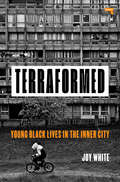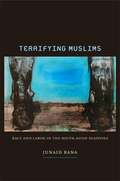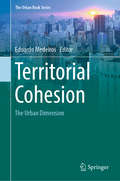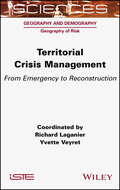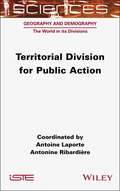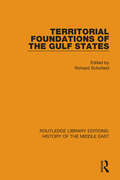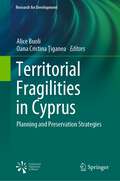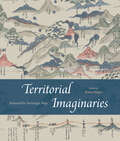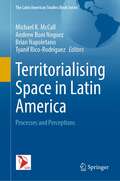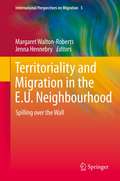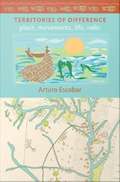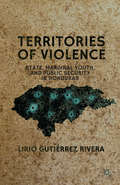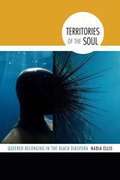- Table View
- List View
Terra Infirma: Geography's Visual Culture
by Irit RogoffHow have issues of place and identity, of belonging and exclusion, been represented in visual culture? Irit Rogoff uses the work of contemporary artists to explore how art in the twentieth century has confronted issues of identity and belonging.
Terraformed: Young Black Lives In The Inner City
by Joy WhiteAn uncompromising wake-up call. Joy White tells uncomfortable truths and blows apart our understanding of racism, crime and policing in our inner-cities.Since the 1980s, austerity, gentrification and structural racism have wreaked havoc on inner-city communities, widening inequality and entrenching poverty. In Terraformed, Joy White offers an insider ethnography of Forest Gate -- a neighbourhood in Newham, east London -- analysing how these issues affect the black youth of today. Connecting the dots between music, politics and the built environment, it centres the lived experiences of black youth who have had it all: huge student debt, invisible homelessness, custodial sentences, electronic tagging, surveillance, arrest, ASBOs, issues with health and well-being, and of course, loss. Part ethnography, part memoir, Terraformed contextualises the history of Newham and considers how young black lives are affected by racism, neoliberalism and austerity.
Terrain Evaluation
by Colin W. MitchellWritten from the point of view of the earth scientist, this book acts as an introduction to terrain evaluation. The emphasis throughout is on the physical rather than the economic, social or legal aspects of the subject, and topics covered include remote sensing and data processing technologies.
Terrestrial Navigation: A Primer for Deck Officers and Officer of the Watch Exams
by Philip M. SmithTerrestrial Navigation: A Primer for Deck Officers and Officer of the Watch Exams prepares the reader for the Officer of the Watch and Master/Mate certificates required by all officers on commercial seagoing vessels. Revision and self-test guide to all navigation-related elements contained within the Officer of the Watch exams are included. Top tips are highlighted throughout the book. The case studies and checklists have been designed to add context and aid recall. From basic trigonometry and plane sailings plotting, right through to practice questions with answers, and mock exam papers, this book will provide you with all the reference material you need to pass your exams.
Terrified: How Anti-Muslim Fringe Organizations Became Mainstream
by Chris BailIn July 2010, Terry Jones, the pastor of a small fundamentalist church in Florida, announced plans to burn two hundred Qur'ans on the anniversary of the September 11 attacks. Though he ended up canceling the stunt in the face of widespread public backlash, his threat sparked violent protests across the Muslim world that left at least twenty people dead. In Terrified, Christopher Bail demonstrates how the beliefs of fanatics like Jones are inspired by a rapidly expanding network of anti-Muslim organizations that exert profound influence on American understanding of Islam.Bail traces how the anti-Muslim narrative of the political fringe has captivated large segments of the American media, government, and general public, validating the views of extremists who argue that the United States is at war with Islam and marginalizing mainstream Muslim-Americans who are uniquely positioned to discredit such claims. Drawing on cultural sociology, social network theory, and social psychology, he shows how anti-Muslim organizations gained visibility in the public sphere, commandeered a sense of legitimacy, and redefined the contours of contemporary debate, shifting it ever outward toward the fringe. Bail illustrates his pioneering theoretical argument through a big-data analysis of more than one hundred organizations struggling to shape public discourse about Islam, tracing their impact on hundreds of thousands of newspaper articles, television transcripts, legislative debates, and social media messages produced since the September 11 attacks. The book also features in-depth interviews with the leaders of these organizations, providing a rare look at how anti-Muslim organizations entered the American mainstream.
Terrifying Muslims: Race and Labor in the South Asian Diaspora
by Junaid RanaTerrifying Muslims highlights how transnational working classes from Pakistan are produced, constructed, and represented in the context of American empire and the recent global War on Terror. Drawing on ethnographic research that compares Pakistan, the Middle East, and the United States before and after 9/11, Junaid Rana combines cultural and material analyses to chronicle the worldviews of Pakistani labor migrants as they become part of a larger global racial system. At the same time, he explains how these migrants' mobility and opportunities are limited by colonial, postcolonial, and new imperial structures of control and domination. He argues that the contemporary South Asian labor diaspora builds on and replicates the global racial system consolidated during the period of colonial indenture. Rana maintains that a negative moral judgment attaches to migrants who enter the global labor pool through the informal economy. This taint of the illicit intensifies the post-9/11 Islamophobia that collapses varied religions, nationalities, and ethnicities into the threatening racial figure of "the Muslim. " It is in this context that the racialized Muslim is controlled by a process that beckons workers to enter the global economy, and stipulates when, where, and how laborers can migrate. The demonization of Muslim migrants in times of crisis, such as the War on Terror, is then used to justify arbitrary policing, deportation, and criminalization.
Territorial Change and Conflict in Indonesia: Confronting the Fear of Secession (Routledge Contemporary Southeast Asia Series)
by Ratri IstaniaThis book focuses on Indonesia and investigates why competition between various identity-affiliated groups to claim a new province, increases conflict severity. It includes a quantitative study, along with complementary case studies of provinces in Indonesia, which provide evidence that group fragmentation plays a role in determining conflict during a new province's struggle. Against the background of the Indonesian government's Territorial Autonomy (TA) strategy, regional proliferation or pemekaran, the author examines the long-term decentralization project in Indonesia, which has an ethnically and religiously divided population. The book provides answers to the questions of how the new province claim increase conflict in the supporting districts and how competition among diverse elites in districts pursuing a new province precipitate conflict within the region. Based on extensive field research, the four case studies of districts with varying degrees of conflict reveal that the campaign for a new province proliferation increases the probability of conflict at the district level and conflict can escalate during the initiation of a new province stage. The author argues that more provinces may be necessary to ensure the fair distribution of wealth that would enable the whole population to enjoy a similar quality of life and that the Indonesian government needs to wisely and strategically uphold its unity if a federal arrangement is not an option. Offering a novel contribution to the study of the relationship between territorial change and conflict in Indonesia, this book will be of interest to academics studying Indonesian politics, Southeast Asian politics as well as ethnic politics.
Territorial Cohesion: Cohesion, Development, Impact Assessment And Cooperation (Routledge Advances In European Politics Ser.)
by Eduardo MedeirosThis book offers a comprehensive overview of several urban related aspects that are of central importance to successful territorial cohesion processes. In essence, it sheds new light on issues concerning urban polycentrism, functional urban regions, integrated sustainable urban development, and the EU Urban Agenda; and on how they can help to achieve territorial cohesion policy goals. As an elusive and fairly recent concept, territorial cohesion has to date only been vaguely debated in the available literature, which for the most part focuses on its historical origins and its relevance for EU policymaking. Instead, this book synthesizes, for the first time, a range of perspectives that place urban elements and policies at the core of territorial cohesion analysis. As such, and given the fact that territorial cohesion is a holistic concept, the book will appeal to a broad readership from both the academic and policymaking arenas.
Territorial Crisis Management: From Emergency to Reconstruction
by Yvette Veyret Richard LaganierOur societies have become very crisis-prone. This book explores crises and the methods of anticipation, management and reconstruction, and considers a risk-crisis-territorial development continuum. The aim is to better understand a widely used concept and clarify the methods of action in the field of crisis management. The different forms of learning proposed to better face future crises are also questioned.This book invites us to analyze the resources available to support crisis management and reconstruction, and consider the unequal access to these resources in different territories in order to design future territorial strategies. This often results in a form of territorial inertia after the crises. However, some innovate, imagine renewed territories, prepare for reconstruction, or even recompose territories now in order to make them more resilient. The crisis can then be the driving force or the accelerator of these changes and contribute to the emergence of new practices, or even new urban and territorial utopias.
Territorial Division for Public Action (ISTE Invoiced)
by Antoine Laporte Antonine RibardièreThe reader may be amazed when they are faced with the sheer number of territorial divisions associated with public action, and full of questions. What justifies this diversity? What are the problems that arise from these divisions? Why don't the limits of public action simply follow administrative and political subdivisions? Territorial Division for Public Action focuses on the situation in France, proposing three different approaches. First, we consider the functions that are associated with these territorial divisions: equitable distribution of resources across the territory, administration and the management of public services. However, they are also a tool for maintaining power. Lastly, we consider the effects these divisions have on the implementation of public action and on socio-spatial structures. These divisions reflect political projects, which embody the issues as much as the partition design itself does. The recent reform of territorial regions, alongside a gradual imposition of intercommunal links in France, has given rise to political debates at both local and national levels.
Territorial Foundations of the Gulf States (Routledge Library Editions: History of the Middle East #12)
by Richard SchofieldThis book, first published in 1994, provides a comprehensive treatment of a crucial set of geopolitical issues from a region where political developments are observed with great care and some trepidation by the rest of the world. Based on expert analysis by leading researchers, the book is the first English-language to deal collectively with the origins and contemporary status of land and maritime boundaries in the Gulf and Arabian Peninsula. The 1990 Iraqi invasion of Kuwait was the gravest challenge yet posed to the system of small states established by Britain during its stay as a protecting power along the western Gulf littoral. Immediately, questions were raised about the origins of these tiny emirates: How had this territorial framework evolved? What was its raison d’être? How capable was this framework of withstanding serious internal and external upheaval such as that caused by the Iraqi invasion? This book reviews these and related concerns from a variety of informed perspectives: those of the boundary-maker himself, the international lawyer, the oil economist, and the political and historical geographer. The origins of the region’s framework of state territory are carefully scrutinised, as are the region’s borders and the contemporary disputes over their status. The period following the first Gulf War has witnessed an increase in the prevalence of Arabian territorial disputes. Some ae new, such as Saudi-Qatar, but most are established cyclical affairs. Although a complete explanation for these developments is premature, they have occurred as states in the region have been making clear moves to finalise the framework of Arabian state territory; only the Saudi-Yemen border remains indeterminate, albeit the subject of current negotiations. The book begins with a major scene-setting chapter by Richard Schofield. This is followed by chapters containing expert insights into the relationship between territory and indigenous notions of sovereignty, Britain’s role in drawing Arabian territorial limits (including a contribution from someone who drew up some of its boundaries), Iran-Kuwait disputes in particular, maritime boundaries, the hydrocarbon dimension, and concepts of shared political space. With many newly-drawn maps based on original research, this volume stands alone as a comprehensive reader on an issue that plays a dominant part in the regional geopolitics of the Gulf and Arabian Peninsula.
Territorial Fragilities in Cyprus: Planning and Preservation Strategies (Research for Development)
by Alice Buoli Oana Cristina ŢiganeaIn this book, the authors present a combination of research-by-design, place-based, and policy-oriented approaches to the territorial fragilities of Nicosia. Nicosia, in Cyprus, is a city divided. Since 1974, a 180 km long Buffer Zone has separated the Turkish Republic of Northern Cyprus (TRNC) and the Republic of Cyprus (RoC). This "open wound" cuts through the city's historical center, crossing the Venetian walls, a key cultural heritage asset, and impacting the city's spatial and cultural identity. Outcomes of an inter-doctoral research initiative, this edited book documents the local realities of the divided city and tests scenarios and spatial patterns of intervention to cope with the partition through the enhancement of local cultural heritage.The book targets an academic audience, architects, urban planners, heritage preservation professionals and policymakers, providing a transferable research method relevant to those approaching a complex, fragile, and contested "border territory".
Territorial Governance and Spatial Transformation in Post-apartheid South Africa (Local and Urban Governance)
by Daniel Du PlessisThe book provides a reflective account of the evolution of the territorial governance structures and processes in South Africa over a period of 30 years after the transition to a post-apartheid society in 1994. It also considers the role and influence of these changing governance institutions and processes and their associated outputs (in the form of policies and plans) on several priority dimensions of urban spatial transformation. The synthesis of the experiences and lessons learnt provides the bases for contemplating important future focus areas for territorial governance such as spatial transformation towards smart cities, an African perspective for future South African cities, and transitioning towards a streamlined integrated territorial governance system. The lessons and experiences are not only of local significance in South Africa, but also globally in countries and regions faced with territorial governance and spatial transformation challenges.
Territorial Imaginaries: Beyond the Sovereign Map
by Kären WigenFresh offerings on world mapping beyond Western conventions. This strikingly colorful volume contends that modern mapping has never been sufficient to illustrate the complex reality of territory and political sovereignty, whether past or present. For Territorial Imaginaries, editor Kären Wigen has assembled an impressive slate of experts, spanning disciplines from political science to art history, to contribute perspectives and case studies covering three main themes: mapping before the nation-state, rethinking and critiquing mapping practices, and robust traditions of counter-cartography. Each contributor proposes alternative ways to think about mapping, and the essays are supported with rich archival documentation. Among the far-reaching case studies are Barbara Mundy’s cartographic history of Indigenous dispossession in the Americas, Peter Bol’s examination of two Chinese maps created five hundred years apart, and Ali Yaycıoğlu’s exploration of tensions between top-down and bottom-up mapping of Habsburg and Ottoman border claims.
Territorial Inequalities
by Magali Talandier Josselin TallecSpatial planning has embraced the idea of dealing with territorial inequalities by focusing on equipment logic on a national scale, and then economic development on a local scale. Today, this issue is creating new angles of debate with strong political resonances (e.g. Brexit, French gilets jaunes movement). Interpretations of these movements are often quick and binary, such as: the contrast between metropolises and peripheries, between cities and the countryside, between the north and the south or between the east and the west of the European Union. Territorial Inequalities sheds light on the social, political and operational implications of these divergences. The chapters cover the subject at different scales of action and observation (from the neighborhood to the world), but also according to their interdependences. To deal with such a vast and ambitious theme, the preferred approach is that of territorial development in terms of public policy, namely spatial planning.
Territorial Water Cooperation in the Central Plateau of Iran
by Majid Labbaf KhaneikiThis book tries to answer the question how different communities in such an arid area as the Iranian central plateau could have shared their limited water resources in a perfect harmony and peace over the course of history. They invented some indigenous technologies as well as cooperative socio-economic systems in order to better adapt themselves to their harsh environment where the scarce water resources had to be rationed among the different communities as sustainably as possible. Those stories hold some lessons for us on how to adjust our needs to our geographical possibilities while living side by side with other people. This work gives insight into the indigenous adaptation strategies through the territorial water cooperation, and describes how water can appear as a ground for cooperation. It explains the water supply systems and social aspects of water in central Iran. Topics include the territorial water cooperation, qanat’s, the traditional water management and sustainability, the socio-economic context, the sustainable management of shared aquifers system and more.
Territorialising Space in Latin America: Processes and Perceptions (The Latin American Studies Book Series)
by Michael K. McCall Andrew Boni Noguez Brian Napoletano Tyanif Rico-RodríguezThe vision of this book is to bring together examples of grounded geographic research carried out in Latin America regarding territorial processes. These encompass a range of histories, processes, strategies and mechanisms, with case studies from ten countries and many regions: struggles to reclaim indigenous lands, conflicts over land/resource/environmental services, competing land claims, urban territorial identities, state power strategies, commercial involvements and others. The case studies included in the book represent a wide diversity of theoretical and methodological framings currently deployed in Latin America to help interpret the patterns and processes through the conceptual lenses of territory, territoriality and territorialization. Interrogating the meanings of territory introduces multiple spatial, socio-cultural and political concepts including space, place and landscape, power, control and governance, and identity and gender.
Territoriality and Migration in the E.U. Neighbourhood: Spilling over the Wall
by Margaret Walton-Roberts Jenna HennebryThis volume brings together an interdisciplinary group of scholars around an important question: how has migration changed in Europe as the European Union has enlarged, and what are the consequences for countries (and for migrants themselves) inside and outside of these redrawn jurisdictional and territorial borders? By addressing this question the book contributes to three current debates with respect to EU migration management: 1) that recent developments in EU migration management represent a profound spatial and organizational reconfiguration of the regional governance of migration, 2) the trend towards the externalization or subcontracting of migration control and, 3) how the implications of Europe's changing immigration policy are increasingly felt across the European neighborhood and beyond. Based on new empirical research, the authors in this collection explore these three processes and their consequences for both member and non-member EU states, for migrants themselves, and for migration systems in the region. The collection indicates that despite the rhetoric of social and spatial integration across the EU region, as one wall has come down, new walls have gone up as novel migration and security policy frameworks have been erected - making European immigration more complex, and potentially more influential beyond the EU zone, than ever.
Territorializing the Chinese Nation-State: Cartography, Geopolitics, and Huang Maocai's Mission to India (1878–1880)
by Kamal Sheel and Ranjana SheelThis book is the first annotated translation of the travelogues of Huang Maocai. A trained Chinese cartographer in the service of the imperial Qing state, he was officially deputed to ascertain the Tibet–India land route and the geopolitical status of British India in the nineteenth century. His travelogues are the first authoritative modern Chinese texts exploring the physical and ideological connections between China and India. Unpublished for a long time, and so far, unavailable in an English translation, these texts provide meaning to many key issues that enshroud the concepts of civilization and nation.An important contribution to the study of Sino–Indian interactions, it demonstrates Huang Maocai's keen observation of the geopolitics of the region. His vivid descriptions of Kolkata and nearby regions enlighten the Chinese perception of colonial India. This book will be an indispensable resource for students and researchers of nation, nationalism, civilization, empire, frontiers and borders, modern history, translation studies, Chinese studies, and Asian studies.
Territories and Trajectories: Cultures in Circulation
by Homi K. Bhabha Diana SorensenThe contributors to Territories and Trajectories propose a model of cultural production and transmission based on the global diffusion, circulation, and exchange of people, things, and ideas across time and space. This model eschews a static, geographically bounded notion of cultural origins and authenticity, privileging instead a mobility of culture that shapes and is shaped by geographic spaces. Reading a diverse array of texts and objects, from Ethiopian song and ancient Chinese travel writing to Japanese literature and aerial and nautical images of the Indian Ocean, the contributors decenter national borders to examine global flows of culture and the relationship between thinking at transnational and local scales. Throughout, they make a case for methods of inquiry that encourage innovative understandings of borders, oceans, and territories and that transgress disciplinary divides. Contributors. Homi Bhabha, Jacqueline Bhabha, Lindsay Bremner, Finbarr Barry Flood, Rosario Hubert, Alina Payne, Kay Kaufman Shelemay, Shu-mei Shih, Diana Sorensen, Karen Thornber, Xiaofei Tian
Territories of Citizenship
by Eva Erman Ludvig BeckmanA comprehensive exploration of theories of citizenship and inclusiveness in an age of globalization. The authors analyze democracy and the political community in a transnational context, using new critical, conceptual and normative perspectives on the borders, territories and political agents of the state.
Territories of Difference: Place, Movements, Life, Redes
by Arturo EscobarIn Territories of Difference, Arturo Escobar, author of the widely debated book Encountering Development, analyzes the politics of difference enacted by specific place-based ethnic and environmental movements in the context of neoliberal globalization. His analysis is based on his many years of engagement with a group of Afro-Colombian activists of Colombia's Pacific rainforest region, the Proceso de Comunidades Negras (PCN). Escobar offers a detailed ethnographic account of PCN's visions, strategies, and practices, and he chronicles and analyzes the movement's struggles for autonomy, territory, justice, and cultural recognition. Yet he also does much more. Consistently emphasizing the value of local activist knowledge for both understanding and social action and drawing on multiple strands of critical scholarship, Escobar proposes new ways for scholars and activists to examine and apprehend the momentous, complex processes engulfing regions such as the Colombian Pacific today. Escobar illuminates many interrelated dynamics, including the Colombian government's policies of development and pluralism that created conditions for the emergence of black and indigenous social movements and those movements' efforts to steer the region in particular directions. He examines attempts by capitalists to appropriate the rainforest and extract resources, by developers to set the region on the path of modernist progress, and by biologists and others to defend this incredibly rich biodiversity "hot-spot" from the most predatory activities of capitalists and developers. He also looks at the attempts of academics, activists, and intellectuals to understand all of these complicated processes. Territories of Difference is Escobar's effort to think with Afro-Colombian intellectual-activists who aim to move beyond the limits of Eurocentric paradigms as they confront the ravages of neoliberal globalization and seek to defend their place-based cultures and territories.
Territories of Violence
by Lirio Gutiérrez RiveraThis book examines the persistence of social violence and public insecurity in Honduras. Using a spatial perspective, the author looks at the Honduran state's security polices - known as Mano Dura - and the challenges authorities face. She points to the state's historical difficulty producing and ordering political territory and space.
Territories of the Soul: Queered Belonging in the Black Diaspora
by Nadia EllisNadia Ellis attends to African diasporic belonging as it comes into being through black expressive culture. Living in the diaspora, Ellis asserts, means existing between claims to land and imaginative flights unmoored from the earth--that is, to live within the territories of the soul. Drawing on the work of Jose Muñoz, Ellis connects queerness' utopian potential with diasporic aesthetics. Occupying the territory of the soul, being neither here nor there, creates in diasporic subjects feelings of loss, desire, and a sensation of a pull from elsewhere. Ellis locates these phenomena in the works of C.L.R. James, the testy encounter between George Lamming and James Baldwin at the 1956 Congress of Negro Artists and Writers in Paris, the elusiveness of the queer diasporic subject in Andrew Salkey's novel Escape to an Autumn Pavement, and the trope of spirit possession in Nathaniel Mackey's writing and Burning Spear's reggae. Ellis' use of queer and affect theory shows how geographies claim diasporic subjects in ways that nationalist or masculinist tropes can never fully capture. Diaspora, Ellis concludes, is best understood as a mode of feeling and belonging, one fundamentally shaped by the experience of loss.
Territories of the Visual in Spain and Spanish America: Visual Studies and UK Hispanism
by Jo Evans, Julia Biggane and Nuria Triana-ToribioWhile studying the theory and contemporary impact of ‘embodied’ viewing, this book celebrates the emergence and development of Visual Studies as a major subject of research and teaching in the field of Hispanic Studies within the UK over the last thirty years. By exploring current routes of investigation, as well as analysing future pathways for study in the field, seven highly distinguished Spanish and Latin American scholars examine their own entry into Visual Studies, and discuss the major trends and changes which occurred in the field as matters of the visual gradually became embedded in higher-education curricula and research trajectories. Each scholar also lays out a current research project, or interest, concerning Spain or Latin America within the visual field. The projects variously explore different media – including film, sculpture, photography, dance, and performance art – spread across a wide array of geographical locales, including Mexico, Cuba, mainland Spain, and the Canary Islands. Offering a map of current and future research in the field, this book provides the first history of visual studies within UK Hispanism. It will be of lasting value to a wide range of scholars and advanced students of Spanish and Latin American cultural, visual, and film studies. This book was originally published as a special issue of the Bulletin of Spanish Studies.

